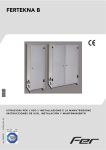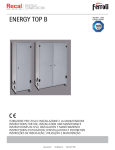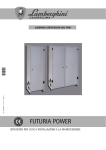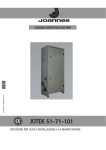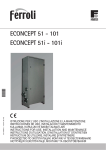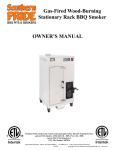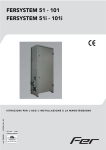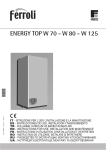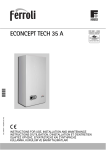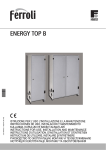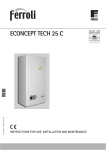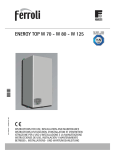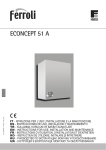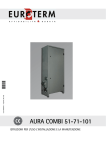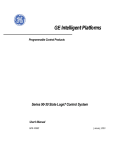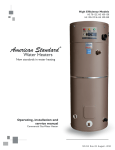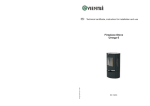Download ENERGY TOP B
Transcript
cod. 3540M631 — 09/2008 (Rev. 00) 3540M631 ENERGY TOP B ISTRUZIONE PER L’USO L'INSTALLAZIONE E LA MANUTENZIONE INSTRUCTIONS FOR USE, INSTALLATION AND MAINTENANCE INSTRUCTIONS D'UTILISATION, D'INSTALLATION ET D'ENTRETIEN INSTRUCCIONES DE USO, INSTALACIÓN Y MANTENIMIENTO INSTRUÇÕES DE INSTALAÇÃO, UTILIZAÇÃO E MANUTENÇÃO ENERGY TOP B B • • • • • • Carefully read the warnings in this instruction booklet since they provide important information on safe installation, use and maintenance. This instruction booklet is an integral part of the product and must be carefully kept by the user for future reference. If the unit is sold or transferred to another owner or if it is to be moved, always make sure that the booklet accompanies the boiler so that it can be consulted by the new owner and/or installer. Installation and maintenance must be carried out by professionally qualified personnel, according to current regulations and the manufacturer's instructions. Incorrect installation or poor maintenance can cause damage or physical injury. The manufacturer declines any responsibility for damage caused by errors in installation and use or by failure to follow the manufacturer's instructions. Before carrying out any cleaning or maintenance operation, disconnect the unit from the electrical power supply using the switch and/or the special cut-off devices. • • • • • • In case the unit breaks down and/or functions poorly, deactivate it, do not make any attempt to repair it or directly intervene. Contact professionally qualified personnel. Any repair/replacement of products must only be carried out by qualified professional personnel using exclusively genuine parts. Failure to comply with the above could affect the safety of the unit. Periodical maintenance carried out by qualified personnel is essential for guaranteeing good operation of the unit. This unit must only be used for the purpose for which it was designed. Any other use is considered improper and therefore hazardous. After removing the packing, check the integrity of the contents. Packing materials must not be left within the reach of children as they are potentially hazardous. In case of doubt do not use the unit, and contact the supplier. The images shown in this manual are a simplified representation of the product. In this representation there may be slight, unimportant differences with the supplied product. B This symbol indicates "Caution" and is placed next to all safety warnings. Strictly follow these instructions in order to avoid danger and damage to persons, animals and things. A This symbols calls attention to a note or important notice. Declaration of conformity Manufacturer: FERROLI S.p.A. Address: Via Ritonda 78/a 37047 San Bonifacio VR Italy declares that this unit complies with the following EU directives: • • • • Gas Appliance Directive 90/396 Efficiency Directive 92/42 Low Voltage Directive 73/23 (amended by 93/68) Electromagnetic Compatibility Directive 89/336 (amended by 93/68) President and Legal Representative Cav. del Lavoro Dante Ferroli EN cod. 3540M631 - 09/2008 (Rev. 00) 51 ENERGY TOP B 1 Operating instructions .......................................................................................................... 53 1.1 Introduction........................................................................................................................................... 53 1.2 Control panel ........................................................................................................................................ 54 1.3 Turning on and off ................................................................................................................................ 56 1.4 Adjustments.......................................................................................................................................... 57 2 Installation .............................................................................................................................. 61 2.1 General Instructions ............................................................................................................................. 61 2.2 Place of installation .............................................................................................................................. 64 2.3 Gas and water connections .................................................................................................................. 64 2.4 Electrical connections........................................................................................................................... 75 2.5 Flue connection .................................................................................................................................... 79 2.6 Condensate drain ................................................................................................................................. 83 3 Service and maintenance...................................................................................................... 84 3.1 Adjustments.......................................................................................................................................... 84 3.2 Start-up................................................................................................................................................. 86 3.3 Maintenance ......................................................................................................................................... 86 3.4 Troubleshooting.................................................................................................................................... 87 4 Technical data and characteristics ...................................................................................... 89 4.1 Dimensions and connections ............................................................................................................... 89 4.2 General view and main components .................................................................................................... 91 4.3 Plumbing circuit .................................................................................................................................... 93 4.4 Technical data table ............................................................................................................................. 95 4.5 Diagrams .............................................................................................................................................. 96 4.6 Wiring diagram ..................................................................................................................................... 97 52 cod. 3540M631 - 09/2008 (Rev. 00) ENERGY TOP B 1. Operating instructions 1.1 Introduction Dear Customer, Thank you for choosing ENERGY TOP B, a latest-generation heat generator featuring FERROLIadvanced design and cutting-edge technology. Please read this manual carefully since it provides important information on safe installation, use and maintenance. ENERGY TOP B is a high-efficiency modular premix condensing heat generator for heating with very low emissions , running on natural gas or LPG and arranged for installation in cascade. Each module ENERGY TOP B is equipped with one (version ENERGY TOP B 80 - 125) or two (version ENERGY TOP B 160 - 250) aluminium finned tube exchangers with steel premix burners, housed in a vertical cabinet in epoxy powder coated steel resistant to atmospheric agents. The plumbing circuits of the exchangers, each equipped with its own local circulating pump, run into system delivery and return manifolds inside the module. The control system has a microprocessor, user interface with a large display and advanced cascade control functions. EN cod. 3540M631 - 09/2008 (Rev. 00) 53 ENERGY TOP B 1.2 Control panel 16 17 19 18 20 23 5 22 11 2 4 21 3 13 reset 10 6 8 14 eco comfort 24 1 9 12 15 25 7 fig. 1 - Control panel The control panel is located inside the cabinet. To access it, open the front door with the special key supplied. Key 1= 2= 3= 4= 5= 6= 7= 8= 9= 10 = 11 = 12 = 13 = 14 = 15 = 16 = 17 = 18 = 19 = 54 DHW temperature setting decrease button (with optional hot water tank installed) DHW temperature setting increase button (with optional hot water tank installed) Heating system temperature setting decrease button Heating system temperature setting increase button Display Summer/Winter mode selection button Economy/Comfort mode selection (with optional hot water tank installed) and unit On/Off button Reset button DHW operation (with optional hot water tank installed) Summer mode Multifunction Eco (Economy) mode (with optional hot water tank installed) Heating mode Unit On / Off button Burner On Appears on connecting the Remote Timer Control (optional) Information symbol Top boiler shell Top boiler shell system fault reset request 20 = Fault 21 = Circulating pump On 22 = Appears on connecting the external probe (optional) 23 = Boiler Off 24 = Bottom boiler shell 25 = Bottom boiler shell system fault reset request (model ENERGY TOP B 160 - 250only) cod. 3540M631 - 09/2008 (Rev. 00) EN ENERGY TOP B Indication during operation Heating A heating demand (generated by the Room Thermostat or Remote Timer Control or 0-10 Vdc signal) is indicated by activation of the circulating pump and the radiator (details 13 and 21 - fig. 1). The display (detail 11 - fig. 1) shows the actual heating delivery temperature and, during DHW standby time, the message “d”. Activation of the arrows (details 18 and 24 - fig. 1) indicates which boiler shell is on. || |||| |||| || ||||| ||| ||| reset eco comfort reset eco comfort fig. 2 DHW circuit (with optional hot water tank installed) A hot water tank heating demand is indicated by activation of the circulating pump and the tap (details 9 and 21 fig. 1). The display (detail 11 - fig. 1) shows the actual hot water tank sensor temperature and, during heating standby time, the message “d. Activation of the arrows (details 18 and 24 - fig. 1) indicates which boiler shell is on. reset eco comfort reset eco comfort fig. 3 - Exclude hot water tank (economy) Hot water tank temperature maintaining/heating can be excluded by the user. If excluded, domestic hot water will not be delivered. The hot water tank can be deactivated by the user (ECO mode) by pressing the button (detail 7 fig. 1). In ECO mode the display activates the symbol (detail 12 - fig. 1). To activate COMFORT mode, press the button (detail 7 - fig. 1) again. EN cod. 3540M631 - 09/2008 (Rev. 00) 55 ENERGY TOP B 1.3 Turning on and off Boiler lighting Press the On/Off button (detail 14 fig. 1). A reset reset eco comfort B eco comfort C reset eco comfort reset eco comfort fig. 4 - Boiler lighting • • • • For the following 120 seconds the display will show FH which identifies the heating system air venting cycle. During the first 10 seconds the display will also show the software version of the cards: A = Display card software version B = Top boiler shell control unit software version C = Bottom boiler shell control unit software version (model ENERGY TOP B 160 - 250only) Open the gas cock ahead of the boiler. When the message FH disappears, the boiler is ready to operate automatically whenever there is a room thermostat demand. Turning the boiler off Press the button (detail 7 - fig. 1) for 5 seconds. reset eco comfort fig. 5 - Turning the boiler off When the boiler is turned off, the electronic board is still powered. Domestic hot water (with optional hot water tank installed) and heating operation are disabled. The antifreeze system remains activated. To relight the boiler, press the button 56 (detail 7 fig. 1) again for 5 seconds. cod. 3540M631 - 09/2008 (Rev. 00) EN ENERGY TOP B eco comfort reset fig. 6 The boiler will be immediately ready to operate whenever domestic hot water is drawn (with optional hot water tank installed) or in case of a room thermostat demand. To completely disconnect the power to the unit, press the button detail 14 fig. 1. B The antifreeze system does not work when the power and/or gas to the unit are turned off. To avoid damage caused by freezing during long idle periods in winter, it is advisable to drain all water from the boiler, DHW circuit and system; or drain just the DHW circuit and add a suitable antifreeze to the heating system, complying with that prescribed in sec. 2.3. 1.4 Adjustments Summer/Winter changeover Press the button detail 6 - fig. 1 for 1 second. reset eco comfort fig. 7 The display activates the Summer symbol detail 10 - fig. 1. The heating function is deactivated, whereas the possible production of domestic hot water (with optional external hot water tank) remains activated. The antifreeze system remains activated. To deactivate Summer mode, press the button (detail 6 - fig. 1) again for 1 second. Heating temperature adjustment Operate the heating buttons max. of 90 °C. (details 3 and 4 - fig. 1) to adjust the temperature from a min. of 20 °C to a IIIII IIIII IIIII III IIIIIII III IIIIII reset eco comfort fig. 8 EN cod. 3540M631 - 09/2008 (Rev. 00) 57 ENERGY TOP B DHW temperature adjustment (with optional hot water tank installed) Operate the DHW buttons of 65°C. (details 1 and 2 - fig. 1) to adjust the temperature from a min. of 10 °C to a max. IIIII IIIII IIIII ||||| | |||||| | ||| ||| reset eco comfort fig. 9 Room temperature adjustment (with optional room thermostat) Using the room thermostat, set the temperature required in the rooms. Room temperature adjustment (with optional remote timer control) Using the remote timer control, set the temperature desired in the rooms. The boiler unit will set the system water according to the required room temperature. For information on the remote timer control, please refer to its user's manual. Sliding Temperature When the optional external probe is installed the corresponding symbol (detail 22 - fig. 1) is activated on the control panel display (detail 5 - fig. 1). The boiler control system operates with "Sliding Temperature”. In this mode, the temperature of the heating system is adjusted according outside weather conditions, in order to ensure high comfort and energy saving throughout the year. In particular, as the outside temperature increases the system delivery temperature decreases according to a given “compensation curve”. With Sliding Temperature adjustment, the temperature set with the heating buttons (details 3 and 4 - fig. 1) becomes the maximum system delivery temperature. It is advisable to set a maximum value to allow system adjustment throughout its useful operating range.. The boiler must be adjusted at the time of installation by qualified personnel. Possible adjustments can in any case be made by the user to improve comfort. Compensation curve and curve offset Press the button reset (detail 8 - fig. 1) for 5 seconds, to display the actual compensation curve (fig. 10) which can be modified with the DHW buttons (details 1 and 2 - fig. 1). Adjust the required curve from 1 to 10 according to the characteristic (fig. 12). By setting the curve to 0, sliding temperature adjustment is disabled. III II IIIIIIIIIII II IIII IIIII III I reset eco comfort fig. 10 - Compensation curve 58 cod. 3540M631 - 09/2008 (Rev. 00) EN ENERGY TOP B Press the heating buttons the DHW buttons (details 3 and 4 - fig. 1) to access parallel curve offset (fig. 13), modifiable with (details 1 and 2 - fig. 1). III II III III II IIIII IIIII IIIIIIIIIII reset eco comfort fig. 11 - Parallel curve offset Press the button (detail 8 - fig. 1) again for 5 seconds to exit parallel curve adjustment mode. reset If the room temperature is lower than the required value, it is advisable to set a higher order curve and vice versa. Proceed by increasing or decreasing in steps of one and check the result in the room. 90 85 80 10 9 8 7 6 5 4 70 3 60 2 50 1 40 30 20 20 10 0 -10 -20 fig. 12 - Compensation curves OFFSET = 20 OFFSET = 40 90 85 80 10 9 8 6 5 70 4 60 3 50 2 40 1 30 20 7 20 10 0 -10 -20 90 85 80 10 9 8 7 6 5 4 3 70 2 60 1 50 40 30 20 20 10 0 -10 -20 fig. 13 - Example of parallel compensation curve shift Timer Control (optional) is connected to the boiler, the above adjustments are managed accordA IfingthetoRemote that given in table 1. EN cod. 3540M631 - 09/2008 (Rev. 00) 59 ENERGY TOP B Table. 1 Heating temperature adjustment Adjustment can be made from the Remote Timer Control menu and the boiler control panel. DHW temperature adjustment (with optional hot water tank installed) Adjustment can be made from the Remote Timer Control menu and the boiler control panel. Summer/Winter changeover Summer mode has priority over a possible Remote Timer Control heating demand. Eco/Comfort selection (with optional hot water tank installed) On disabling DHW from the Remote Timer Control menu, the boiler selects the Economy mode. In this condition, the button the boiler panel is disabled. (detail 7 - fig. 1) on On enabling DHW from the Remote Timer Control menu, the boiler selects the Comfort mode. In this condition it is possible select one of the two modes with the button Sliding Temperature (detail 7 - fig. 1). Both the Remote Timer Control and the boiler card manage Sliding Temperature adjustment: of the two, the Sliding Temperature of the boiler card has priority. Water system pressure adjustment The filling pressure with the system cold must be approx. 1.0 bar. If the system pressure falls to values below minimum, the boiler card will activate fault F37 (fig. 14). Flashing of the arrows (details 18 and 24 - fig. 1) together with the error code indicates which boiler shell is in fault status. III I I IIIII IIIIIIIIIIIIIII III IIIIIII III III IIIII III III I I II I I I I I I I I I I I I II I I reset III III I I I I I I I I I I III II III IIIIII I II eco comfort III fig. 14 - System low pressure fault the system pressure is restored, the boiler will activate the 120-second air venting cycle indicated on the A Once display by FH. 60 cod. 3540M631 - 09/2008 (Rev. 00) EN ENERGY TOP B 2. Installation 2.1 General Instructions THE BOILER MUST ONLY BE INSTALLED BY QUALIFIED PERSONNEL, IN COMPLIANCE WITH ALL THE INSTRUCTIONS GIVEN IN THIS TECHNICAL MANUAL, THE PROVISIONS OF CURRENT LAW, THE NATIONAL AND LOCAL REGULATIONS, AND THE RULES OF PROPER WORKMANSHIP. ENERGY TOP B is a heat generator arranged to operate alone or in cascade (bank). When two or more generators are installed in cascade with the original kits ENERGY TOP B, respecting the prescriptionsFERROLIof this manual, they can be considered as a single heat generator of total power equal to the sum of the powers of all the units connected in cascade. All the requirements of the current standards and regulations applicable to this “equivalent” total heating capacity generator must be met. In particular, the place of installation, safety devices and fume exhaust system must be adequate for the total heating capacity of the bank of units. In fact, each ENERGY TOP B is a complete and independent heat generator, equipped with its own safety devices. In case of overtemperature, no water or no circulation in the unit , the protection devices cause the unit to shutdown , preventing its operation. The installation instructions given in the following sections concern both the single unit and connection in cascade. Given below are the possible configurations for connection in cascade. 1700 325 Ø Configurations in line A fig. 15 - Configuration - in line EN cod. 3540M631 - 09/2008 (Rev. 00) 61 ENERGY TOP B Table. 2 - Configurations in line Total power kW 62 Combinations Module 1 Module 2 Module 3 Module 4 Ø A 80 80 / / / / 500 125 125 / / / / 500 160 160 / / 200 1000 250 250 / / 200 1000 240 160 80 / / 200 1500 285 160 125 / / 200 1500 330 250 80 / / 200 1500 375 250 125 / / 200 1500 320 160 160 / / 200 2000 410 250 160 / / 200 2000 500 250 250 / / 200 2000 400 160 160 80 / 200 2500 445 160 160 125 / 200 2500 490 250 160 80 / 200 2500 535 250 160 125 / 300 2500 580 250 250 80 / 300 2500 625 250 250 125 / 300 2500 480 160 160 160 / 300 3000 570 250 160 160 / 300 3000 660 250 250 160 / 300 3000 750 250 250 250 / 300 3000 560 160 160 160 80 300 3500 605 160 160 160 125 300 3500 650 250 160 160 80 300 3500 695 250 160 160 125 300 3500 740 250 250 160 80 300 3500 785 250 250 160 125 300 3500 830 250 250 250 80 300 3500 875 250 250 250 125 300 3500 640 160 160 160 160 300 4000 730 250 160 160 160 300 4000 820 250 250 160 160 300 4000 910 250 250 250 160 300 4000 1000 250 250 250 250 300 4000 cod. 3540M631 - 09/2008 (Rev. 00) EN ENERGY TOP B 475 330 185 1700 A=325 Ø Opposed configurations 120 180 450 A 900 fig. 16 - Opposed configurations Table. 3 - Opposed configurations Total power EN Combinations kW Module 1 Module 2 Module 3 Module 4 Ø A 160 80 80 / / 200 1000 205 125 80 / / 200 1000 250 125 125 / / 200 1000 320 160 160 / / 200 2000 410 250 160 / / 200 2000 500 250 250 / / 200 2000 400 160 160 80 / 200 2500 445 160 160 125 / 200 2500 490 250 160 80 / 200 2500 535 250 160 125 / 300 2500 580 250 250 80 / 300 2500 625 250 250 125 / 300 2500 640 160 160 160 160 300 4000 730 250 160 160 160 300 4000 820 250 250 160 160 300 4000 910 250 250 250 160 300 4000 1000 250 250 250 250 300 4000 cod. 3540M631 - 09/2008 (Rev. 00) 63 ENERGY TOP B 2.2 Place of installation The generator can be installed directly outside or in a special room with ventilation openings to the outside as prescribed by current regulations. If there are several burners or extraction units that can work together in the same room, the ventilation openings must be sized for simultaneous operation of all the units. The place of installation must be free of flammable objects or materials, corrosive gases, volatile substances or dusts. For positioning, leave enough space around the modules for normal maintenance operations. Make sure the front door opens without hindrances. B The air necessary for combustion enters through special openings in the bottom and top part of the appliance. Make sure these air passages are not obstructed in any way. fig. 17 - Air inlet 2.3 Gas and water connections Plumbing connections Make the relevant connections according to the instructions given below. Make the generator connection in such a way that its internal pipes are free of stress. For proper operation and long life of the generator, the plumbing system must be of suitable size and complete with all the accessories that guarantee regular operation and running. In particular, provide for all the protection and safety devices prescribed by current regulations for the complete modular generator. They must be installed on the hot water circuit delivery piping, immediately downstream of the last module, within a distance of 0.5 m, with no shut-off devices in between. A "Safety Device and Circuit Breaker module” equipped with internal hydraulic circuit breaker and safety units with ISPESL certification is available by request. Refer to the price-list or contact our sales network. The unit is not supplied with an expansion tank; its connection must therefore be made by the Installer. B 64 A filter must also be installed on the system return piping to prevent impurities or sludge from the system clogging and damaging the heat generators. The filter must necessarily be installed when replacing generators in existing systems. The manufacturer declines any liability for damage caused to the generator by failure to install or inadequate installation of this filter. cod. 3540M631 - 09/2008 (Rev. 00) EN ENERGY TOP B Water system characteristics In the presence of water harder than 25° Fr, it is advisable to use suitably treated water, in order to avoid possible scaling in the boiler caused by hard water, or corrosion produced by aggressive water. Due to its low thermal conductivity, scaling even just a few mm thick causes significant overheating of the generator walls, with consequent serious problems. Water treatment is indispensable in case of very large systems (containing large amounts of water) or with frequent introduction of replenishing water in the system. If partial or total emptying of the system becomes necessary in these cases, it is advisable to refill with treated water. Gas connection The gas must be connected to the corresponding union with a rigid metal pipe. The gas meter must be adequate for the simultaneous use of all units connected to it. Carry out the generator gas connection in accordance with current regulations. The diameter of the gas pipe leaving the generator does not determine the diameter of the pipe between the unit and the meter; it must be chosen according to its length and pressure loss. B Make sure to install a fuel shutoff valve externally with respect to the modules, enabling the gas to be turned off even without opening the single modules equipped with key closing. Connection instructions ENERGY TOP B is equipped inside with 3 manifolds (gas, system delivery and return) and a condensate drain pipe that facilitate cascade connection and also connection of a single module to the system. The manifolds are sized for a connection in series of up to 1000 kW. The cabinet contains a set of 3 seals (2 for water manifolds, 1 for gas manifold) with respective bolts and nuts, to be used for connection to the next module (connection in cascade). The optional kit code 042027X0 containing 3 blind flanges and 3 drilled flanges with respective seals and screws, is available for the connection to the system . To connect a single module • • • After establishing on which side of the module to make the water and gas connections, connect the flanges with the joining section contained in the kit on that side after suitably welding them to the system pipes. Make sure to correctly fit the special seals contained in the kit. Connect a Ø40 pipe to the condensate drain pipe for removing the condensate produced during operation (see fig. 37) Fit the blind flanges contained in the kit on the opposite side of the module, placing the special seals in between. 2 2 1 1 3 5 7 3 4 fig. 18 1 2 3 4 5 7 EN Gas inlet System delivery System return Condensate drain Blind flanges - kit 042027X0 (optional) Flanges with joining section - kit 042027X0 (optional) cod. 3540M631 - 09/2008 (Rev. 00) 65 ENERGY TOP B To connect several modules in line - fig. 19 • • • • • Connect the first module to the system and gas pipes, as described above, but without fitting the blind flanges on the opposite side of the module to that of the connection. Connect the second module on this side, making sure to align the connection flanges and the condensate drain pipe. Place the seals contained in the kit between the flanges of the two modules. Fit the bolts contained in the kit on the flanges from inside the first module, making them come out of the flanges in the second module. Partially tighten the nuts on the bolts from inside the second module. Before tightening the nuts, make sure all the seals are correctly positioned and fit the condensate drain pipes of the two modules (see fig. 38). Tighten the nuts and repeat the connection operations for the following modules. 2 2 1 1 3 8 5 7 3 4 fig. 19 1 2 3 4 5 7 8 66 Gas inlet System delivery System return Condensate drain Blind flanges - kit 042027X0 (optional) Flanges with joining section - kit 042027X0 (optional) Seals (standard) cod. 3540M631 - 09/2008 (Rev. 00) EN ENERGY TOP B To connect several opposed modules Optional kit code 042026X0 is available for connection of water and gas manifolds in series. The kit contains 3 blind flanges, 3 flanges with joining section, 3 flanged “U“ pipes with respective seals and screws. 2 1 3 8 9 C 7 D 1 B 2 3 A 1 2 2 1 3 3 fig. 20 - Kit for connection of opposed modules A B C D 1 2 • • • • • • EN 1st Module 2nd Module 3rd Module 4th Module Gas inlet System delivery 3 4 5 7 8 System return Condensate drain Blind flanges - kit 042026X0 Flanges with joining section Seals Arrange the modules according to the layout of fig. 20. Connect the first module to the system and gas pipes using the flanges with pipe section and respective seals contained in the kit. Connect the second module, making sure to align the connection flanges and the condensate drain pipe. Place the seals contained in the kit between the flanges of the two modules. Fit the bolts contained in the kit on the flanges from inside the first module, making them come out of the flanges in the second module. Partially tighten the nuts on the bolts from inside the second module. Before tightening the nuts, make sure all the seals are correctly positioned and fit the condensate drain pipes of the two modules (see fig. 38). Tighten the nuts and repeat the connection operations for the "U" pipes and following modules. Fit the blind flanges on the last module. cod. 3540M631 - 09/2008 (Rev. 00) 67 ENERGY TOP B Safety device and separator module (optional) The Safety Device and Separator Module for series ENERGY TOP Bmodular generators is an ISPESL certified module containing a hydraulic separator and safety, protection and control devices required by file “R” section R3A and R3B, intended for use with series ENERGY TOP Bmodular generators. Every ISPESL Safety Device Module comprises a cabinet of the same size and appearance as the modular generators ENERGY TOP B, containing a hydraulic separator with air valve and thermal insulation, the respective system delivery and return manifolds, a gas manifold, and a discharge manifold for the safety valve. The safety devices required by file “R” section R3A and R3B are fitted on the hydraulic manifolds and hydraulic separator body. Provision is also made for the probe pocket of a possible fuel shut-off valve, to be installed in the system , on the outside of the bank of modules . The hydraulic separator contained in the module allows the hydraulic circuit of the modules ENERGY TOP B (primary circuit) to be made independent of the hydraulic circuit of the respective heating system (secondary circuit). The separator is sized for correct operation up to 1000 kW, and the main advantages offered are: • • • • • An external circulating pump for the primary circuit is not necessary. In fact, circulation in the primary circuit is ensured by the circulating pumps contained inside the generators ENERGY TOP B. When the secondary pump is deactivated, also the circulation in the system circuit stops; the entire flow delivered by the circulating pumps contained inside the generators ENERGY TOP B is by-passed through the hydraulic separator. The flow in the primary circuit can remain constant, whereas the secondary circuit can function with a variable or intermittent flow rate. There are no anomalous operating conditions in which the system pumps interact with the circulating pumps in side the generators ENERGY TOP B, creating unwanted head and flow rate variations in the circuits. Sizing of the system circulating pump can be carried out according to the needs of just the secondary circuit. A B 4 4 2 3 2 3 1 1 fig. 21 - Opposed configurations A B 1 2 3 4 68 1st Module 2nd Module Gas inlet System delivery System return Hydraulic separator cod. 3540M631 - 09/2008 (Rev. 00) EN ENERGY TOP B The safety device and separator module must be installed directly next to the last module ENERGY TOP B making up the modular generator. The particular symmetrical shape of the module allows it to installed on the right side and left side of the generator bank. Some possible connection examples are given below. C 4 2 3 1 fig. 22 - Configuration in line C 1 2 3rd Module Gas inlet System delivery 3 4 System return Hydraulic separator Plumbing circuit examples Key of examples I D 42 72 72b 95 ISPESL safety devices Hydraulic separator DHW temperature sensor (not supplied) Room thermostat (not supplied) Room thermostat (not supplied) 3-way valve - with spring return: at rest on DHW side (not supplied) 130 Hot water tank circulating pump (not supplied) 138 External probe (not supplied) 139 298 306 307 Remote control (not supplied) Cascade temperature sensor (not supplied) Heating system circulating pump (not supplied) Heating system second circulating pump (not supplied) SM Delivery probe (supplied with kit FZ4) TS Safety thermostat (not supplied) PZ Zone pump (not supplied) FZ4 Zone regulator Parameters Each system requires a different parametrisation.Follow the procedure for accessing the two menus, given below; for the parameters to be modified, refer to the tables given alongside the plumbing diagrams. "Service Menu" Press the Reset button for 10 seconds to access the card Service Menu. Press the Heating buttons to select "tS", "In", "Hi" or "rE"”. “tS” means Transparent Parameters Menu, “In” Information Menu, “Hi” History Menu, and “rE” History Menu Reset. Select "tS" and press the RESET button. The card has 29 transparent parameters also modifiable from Remote Control (Service Menu). Press the Heating buttons to scroll the list of parameters in increasing or decreasing order. Press the DHW buttons to modify the value of a parameter: the change will be automatically saved. Press the Reset button to return to the Service Menu. Press the Reset button for 10 seconds to exit to the card Service Menu. "System Type Menu" Press the Summer/Winter button for 10 seconds to access the card System Type Menu. The card has 21 transparent parameters. Press the Heating buttons to scroll the list of parameters in increasing or decreasing order. Press the DHW buttons to modify the value of a parameter: the change will be automatically saved. Press the Summer/Winter button for 10 seconds to exit the card System Type Menu. EN cod. 3540M631 - 09/2008 (Rev. 00) 69 ENERGY TOP B One direct heating circuit Check/Change parameter P02 of the "Transparent Parameters Menu" to 1 for ENERGY TOP B 80 - 160 and 4 for ENERGY TOP B 125 - 250. Change parameter P.02 of the "System Type Menu" to 1. Change parameter P.09 of the "System Type Menu" to 1. 138 72/139 I D 298 306 A fig. 23 70 cod. 3540M631 - 09/2008 (Rev. 00) EN ENERGY TOP B One direct heating circuit and one DHW circuit with pump Check/Change parameter P02 of the "Transparent Parameters Menu" to 2 for ENERGY TOP B 80 - 160 and 5 for ENERGY TOP B 125 - 250. Change parameter P.02 of the "System Type Menu" to 1. Change parameter P.09 of the "System Type Menu" to 1. 138 72/139 42 I 130 298 D 306 B fig. 24 EN cod. 3540M631 - 09/2008 (Rev. 00) 71 ENERGY TOP B One direct heating circuit and one DHW circuit with diverter valve Check/Change parameter P02 of the "Transparent Parameters Menu" to 3 for ENERGY TOP B 80 - 160 and 6 for ENERGY TOP B 125 - 250. Change parameter P.02 of the "System Type Menu" to 1. Change parameter P.09 of the "System Type Menu" to 1. Change parameter P.11 of the "System Type Menu" to 1. 138 72/139 42 I 298 D 306 95 C fig. 25 72 cod. 3540M631 - 09/2008 (Rev. 00) EN ENERGY TOP B Two direct heating circuits Check/Change parameter P02 of the "Transparent Parameters Menu" to 1 for ENERGY TOP B 80 - 160 and 4 for ENERGY TOP B 125 - 250. Change parameter P.01 of the "System Type Menu" to 4. Change parameter P.02 of the "System Type Menu" to 1. Change parameter P.09 of the "System Type Menu" to 1. 138 72/139 72b I 307 D 306 298 D fig. 26 EN cod. 3540M631 - 09/2008 (Rev. 00) 73 ENERGY TOP B Two mixed heating circuits and one direct heating circuit Check/Change parameter P02 of the "Transparent Parameters Menu" to 1 for ENERGY TOP B 80 - 160 and 4 for ENERGY TOP B 125 - 250. Change parameter P.02 of the "System Type Menu" to 1. Change parameter P.09 of the "System Type Menu" to 1. For the electrical connection and the zone system settings, refer to the "FZ4 zone regulator" handbook FZ4 72/139 138 72/139 Zona 1 I TS TS PZ PZ SM M D 72/139 Zona 2 Zona 3 PR SM M 298 E fig. 27 74 cod. 3540M631 - 09/2008 (Rev. 00) EN ENERGY TOP B Two mixed heating circuits, one direct heating circuit and one DHW circuit with pump Check/Change parameter P02 of the "Transparent Parameters Menu" to 2 for ENERGY TOP B 80 - 160 and 5 for ENERGY TOP B 125 - 250. Change parameter P.02 of the "System Type Menu" to 1. Change parameter P.09 of the "System Type Menu" to 1. For the electrical connection and the zone system settings, refer to the "FZ4 zone regulator" handbook FZ4 72/139 138 72/139 Zona 1 Zona 2 72/139 Zona 3 42 I TS TS PZ PZ SM M D PR 130 SM M 298 F fig. 28 2.4 Electrical connections Connection to the electrical grid B The unit's electrical safety is only guaranteed when correctly connected to an efficient earthing system executed according to current safety standards. Have the efficiency and suitability of the earthing system checked by professionally qualified personnel. The manufacturer is not responsible for any damage caused by failure to earth the system. Also make sure that the electrical system is adequate for the maximum power absorbed by the unit, as specified on the boiler dataplate. The boiler is prewired and provided with a Y-cable and plug for connection to the electricity line. The connections to the grid must be made with a permanent connection and equipped with a bipolar switch whose contacts have a minimum opening of at least 3 mm, interposing fuses of max. 3A between the boiler and the line. It is important to respect the polarities (LINE: brown wire / NEUTRAL: blue wire / EARTH: yellow-green wire) in making connections to the electrical line. During installation or when changing the power cable, the earth wire must be left 2 cm longer than the others. B The user must never change the unit's power cable. If the cable gets damaged, switch off the unit and have it changed solely by professionally qualified personnel. If changing the electric power cable, use solely “HAR H05 VV-F” 3x0.75 mm2 cable with a maximum outside diameter of 8 mm. Room thermostat (optional) B EN CAUTION: The room thermostat must have clean contacts. CONNECTING 230 V. TO THE TERMINALS OF THE ROOM THERMOSTAT WILL IRREPARABLY DAMAGE THE ELECTRONIC CARD. When connecting a remote timer control or a timer switch, do not take the power supply for these devices from their cut-out contacts. Their power supply must be taken with a direct connection from the mains or with batteries, depending on the kind of device. cod. 3540M631 - 09/2008 (Rev. 00) 75 ENERGY TOP B External probe (optional) Connect the probe to its respective terminals. The maximum permissible length for the boiler - external probe connection electrical cable is 50 m. A normal 2-wire cable can be used. The external probe should preferably be installed on the North, North-West wall or that facing the largest area of living room. The probe must never be exposed to the early morning sun or, insofar as possible, direct sunlight; protect it if necessary. In any case, the probe must not be installed near windows, doors, ventilation openings, flues or heat sources that could affect the reading. fig. 29 - External probe positioning not recommended 76 cod. 3540M631 - 09/2008 (Rev. 00) EN ENERGY TOP B Accessing the electrical terminal block The electrical terminal block is located inside a sealed box at the bottom left of the cabinet. Make the electrical connections as shown in the wiring diagram on sec. 49 and run the cables through the special cable glands. 4 5 6 7 8 9 A ( (( 300 306 10 11 12 ( B C 301 302 25 26 27 28 29 30 130/307 95 13 14 15 16 299 72 17 18 19 20 21 22 23 24 138 298 72B 42 139 fig. 30 - Electrical terminal block 42 72 72b 95 DHW temperature sensor (not supplied) Room thermostat (not supplied) Room thermostat (not supplied) Diverter valve (not supplied) A = Heating phase B = DHW phase C = Neutral 130 138 139 298 299 300 301 302 306 307 EN NOTE: For valves with 2 wires and spring return, use the connections B and C DHW circulating pump (not supplied) External probe (not supplied) Remote timer control (not supplied) Cascade temperature sensor (not supplied) Input 0-10 Vdc Burner lit contact (voltage-free contact) Fault contact (voltage-free contact) Remote reset input (230 Volt) Heating system circulating pump (not supplied) Heating system second circulating pump (not supplied) cod. 3540M631 - 09/2008 (Rev. 00) 77 ENERGY TOP B For the connection in cascade 1. Connect the modules as shown in fig. 31 A B C D 25 26 27 28 29 30 25 26 27 28 29 30 25 26 27 28 29 30 25 26 27 28 29 30 fig. 31 - Connection in cascade A 1st Module B 2nd Module C 3rd Module D 4th Module 2. Carry out all the electrical connections (terminals 4 to 24) on module no. 1 3. On the remaining modules only connect the power supply and possible contacts for: burner lit (300), fault contact (301) and remote reset input (302). 4. Switch on the power to the entire cascade 5. After the "FH" procedure, check correct operation of the cascade: • • • • Module 1: arrow symbol at top left of the display Module 2: arrow symbol at bottom right of the display Module 3: arrow symbol at bottom right of the display Module 4: arrow symbol at top right of the display If this does not occur, disconnect the power and check the wiring in fig. 31. Settings All adjustments must be made on module no. 1. Possible faults If the electrical connection of a module is disconnected for some reason, module 1 will activate fault F70. If the electrical connection of a module is disconnected for some reason , the next module will activate fault F71. 78 cod. 3540M631 - 09/2008 (Rev. 00) EN ENERGY TOP B 2.5 Flue connection Important The unit is a B23 type with combustion air drawn from the installation room and fume exhaust by means of a fan (operation with flue under pressure) and must be connected to one of the discharge systems indicated below. Before proceeding with installation, check and carefully comply with the local regulations and provisions. Also comply with the provisions concerning the positioning of wall and/or roof terminals and the minimum distances from windows, walls, ventilation openings, etc. Manifold, ducts and flue must be suitably sized, designed and made in compliance with the current standards. They must be made of suitable materials, i.e. resistant to heat and corrosion, smooth on the inside and hermetic. In particular, joints must be condensate-proof. Also provide for suitable condensate drainage points, connected through a trap to prevent the condensate produced in the flues from running into the generators. B The unit is equipped with one (models ENERGY TOP B 80 - 125) or two (models ENERGY TOP B 160 - 250) separate Ø80 flue connections for the two burner - exchanger units. The combustion circuits of the two units are completely independent. When joining the two fume outlets to a single flue or manifold (in case of a single module or connection in cascade) it is necessary to install a fume anti-backflow valveon each outlet to prevent operation anomalies or the creation of hazardous conditions. Make sure to use the optional FERROLIkits , provided with special anti-backflow valves. carrying out the flue connection, make sure to fill the condensate trap with approx. 0.5 litres of water A Before through the flue connections. Connection with separate pipes Separate Ø80 ducts can be connected directly to the unit. Insert the seal 1KWMA84A on the Ø80 pipes leaving the unit and make it adhere to the upper wall of the cabinet. Before proceeding with installation, make sure the maximum permissible length has not been exceeded, by means of a simple calculation: 1. Establish the layout of the system of split flues, including accessories and outlet terminals for each of the two burner/ exchanger bodies. 2. Consult the table 5 and identify the losses in meq (equivalent metres) of every component, according to the installation position. 3. Check that the sum total of losses is less than or equal to the maximum permissible length in table 4. Table. 4 - Max. length separate ducts Separate ducts For each single Exchanger/Burner Body Max. permissible length 20 meq Table. 5 - Accessories Losses in meq Fume exhaust Ø 80 Horizontal 1.6 2.0 1 m M/F 1KWMA83W BEND 45° M/F 1KWMA65W 1.8 90° M/F 1KWMA01W 2.0 PIPE SECTION TERMINAL FLUE EN Vertical PIPE with test point 1KWMA70W 0.3 fumes, wall with antiwind 1KWMA86A 5.0 Split air/fumes 80/80 1KWMA84U 5.0 cod. 3540M631 - 09/2008 (Rev. 00) 79 ENERGY TOP B Direct connection of Ø80 terminals code 041013X0 Each single module can be connected directly to the terminal kits 041013X0, even with connection in bank , as given in fig. 32. Each kit comprises a Ø80 terminal with grille (ref. 3), a seal (ref. 1) and a centering ring (not used in this model). For models ENERGY TOP B 160 - 250 use 2 kits perENERGY TOP B 80 - 125module, and 1 kit for models . 3 1 fig. 32 B B 80 Before installing the flues, fill the trap with approx. 0.5 l of water through the flue connections. For outside installations make the seal 1 adhere perfectly to top part of the cabinet to prevent infiltration of rain and atmospheric agents. cod. 3540M631 - 09/2008 (Rev. 00) EN ENERGY TOP B Connection with manifolds To connect one or more modules in bank to a single flue, it is advisable to use the special manifolds (optionals) indicated in the table. The choice of diameter must be made according to the total power of the bank of units, respecting that given in the table. Use a starting kit for each bank (containing manifold plug and trap) and a suitable number of manifolds (one for each ENERGY TOP B 80 - 125 and two for each ENERGY TOP B 160 - 250). 90° bends and manifold extensions are also available for the flue connection. Coil heating capacity Manifold diameter Manifold kit L=500 Starting kit C 041028X0 in line Up to 500 kW 200 mm Up to 1000 kW 041026X0 opposed E 041030X0 in line D 041029X0 300 mm 041027X0 F 041031X0 opposed Manifold extension M/F L=1000 Manifold 90° bend 041019X0 041016X0 041036X0 041035X0 Installation examples with modules in line B A C C C D D EN D D fig. 34 fig. 33 A - 041026X0 B - 041027X0 C - 041028X0 D - 041029X0 D Ø 300 Ø 200 C - Starting kit Ø200 - Starting kit Ø300 - Manifold kit Ø200 in line - Manifold kit Ø300 in line cod. 3540M631 - 09/2008 (Rev. 00) 81 ENERGY TOP B Installation examples with opposed modules A B E F F F Ø 300 Ø 200 F fig. 36 fig. 35 A - 041026X0 B - 041027X0 E - 041030X0 F - 041031X0 82 - Starting kit Ø200 - Starting kit Ø300 - Manifold kit Ø200 opposed - Manifold kit Ø300 opposed cod. 3540M631 - 09/2008 (Rev. 00) EN ENERGY TOP B 2.6 Condensate drain B The boiler has an internal condensate drain trap connected to an internal condensate outlet manifold. Condensate drain connection using one generator 1 A 1 B fig. 37 - Condensate drain connection with one generator A B Place the Ø40 pipe 1 (not supplied) on the side of the generator. Slide the pipe 2 towards the arrow side at least 2-3 cm in order to insert it in the pipe 1. Condensate drain connection using two or more generators 1 A 2 2 B fig. 38 - Condensate drain connection with several generators A B EN Place the Ø40 pipe 1 (not supplied) on the side of the generator. Slide the pipe 2 (of each generator) towards the arrow side at least 2-3 cm in order to insert it in the pipe 1. cod. 3540M631 - 09/2008 (Rev. 00) 83 ENERGY TOP B 3. Service and maintenance All adjustment, conversion, start-up and maintenance operations described below must only be carried out by Qualified Personnel (meeting the professional technical requirements prescribed by current regulations) such as those of the Local AfterSales Technical Service. FERROLI declines any liability for damage and/or injury caused by unqualified and unauthorised persons tampering with the unit. 3.1 Adjustments Gas supply conversion The unit can operate on Natural Gas or LPG and is factory-set for use with one of these two gases, as clearly shown on the packing and on the dataplate. Whenever a different gas to that for which the unit is arranged has to be used, a conversion kit will be required, proceeding as follows: 1. 2. 3. 4. Using the special key supplied, open the cabinet of the upper exchanger body. Loosen the gas valve fixing ring “A. Undo the three fixing screws “B” and remove the gas valve “C“. Replace the gas valve “D” positioning it inside the seal “E”, with that contained in the conversion kit. Refit the parts and check the tightness. 5. Repeat steps 2, 3 and 4 for the lower exchanger body (model ENERGY TOP B 160 - 250only) 6. Modify the parameter on control system. • • • • • turn the boiler onto standby press the DHW buttons (details 1 and 2 - fig. 1) for 10 seconds: the display shows “P01“ flashing. Press the DHW buttons fig. 1 (details 1 and 2 - ) to set parameter 00 (for natural gas operation) or 01 (for LPG operation). press the DHW buttons (details 1 and 2 - fig. 1) for 10 seconds. the boiler will go back onto standby 7. Apply the label, contained in the conversion kit, near the dataplate. 8. Using a combustion analyser connected to the boiler fume outlet, make sure the CO2 content in the fumes, with the boiler operating at max. and min. output, complies with that given in the technical data table for the corresponding type of gas. 2 1 C A D E B E D A C B fig. 39 - Gas conversion 1 2 84 Model ENERGY TOP B 125 - 250 Model ENERGY TOP B 80 - 160 cod. 3540M631 - 09/2008 (Rev. 00) EN ENERGY TOP B Activating TEST mode Press the heating buttons (details 3 and 4 - fig. 1) at the same time for 5 seconds to activate TEST mode. The boiler lights at the maximum heating power set as described in the following section. The heating symbol (detail 13 - fig. 1) and DHW symbol (detail 9 - fig. 1) flash on the display; the heating power will be displayed alongside. IIIIIIII II IIIIIII IIIIIII IIII IIIIIII II IIIIIII reset eco comfort fig. 40 - TEST mode (heating power = 100%) To deactivate TEST mode, repeat the activation sequence. TEST mode is automatically disabled in any case after 15 minutes. Only for model ENERGY TOP B 160 - 250 In TEST mode, press the button (detail 7 - fig. 1) to obtain the following operation: • • • Top boiler shell on; bottom boiler shell off. Top boiler shell off; bottom boiler shell on. Top boiler shell on; bottom boiler shell on. Heating power adjustment To adjust the heating power, switch the boiler to TEST mode (see sec. 3.1). Press the heating buttons 100). Press the button sec. 3.1). EN reset (details 3 and 4 - fig. 1) to increase or decrease the power (min. = 00 - max. = (detail 8 - fig. 1) within 5 seconds; max. power will remain that just set. Exit TEST mode (see cod. 3540M631 - 09/2008 (Rev. 00) 85 ENERGY TOP B 3.2 Start-up B Checks to be made at first lighting, and after all maintenance operations that involved disconnection from the systems or an operation on safety devices or parts of the boiler: Before lighting the boiler • • • • • • • • • Open any on-off valves between the boiler and the systems. Check the tightness of the gas system, proceeding with caution and using a soap and water solution to detect any leaks in connections. Check correct prefilling of the expansion tank (ref. sec. 4.4). Fill the water system and make sure all air contained in the boiler and the system has been vented, by opening the air vent valve on the boiler and any vent valves on the system. Fill the condensate trap and check correct connection of the condensate elimination system. Make sure there are no water leaks in the system, DHW circuits, connections or boiler. Check correct connection of the electrical system and efficiency of the earthing system Make sure the gas pressure value for heating is that required. Make sure there are no flammable liquids or materials in the immediate vicinity of the boiler Checks during operation • • • • • • • • • • Turn the unit on as described in sec. 1.3. Make sure the fuel circuit and water systems are tight. Check the efficiency of the flue and air-fume ducts while the boiler is working. Check the correct tightness and functionality of the condensate elimination system and trap. Make sure the water is circulating properly between the boiler and the systems. Make sure the gas valve modulates correctly in the heating and domestic hot water production phases. Check proper boiler lighting by doing several tests, turning it on and off with the room thermostat or remote control. Using a combustion analyser connected to the boiler fume outlet, check that the CO2 content in the fumes, with the boiler operating at max. and min. output, corresponds to that given in the technical data table for the corresponding type of gas. Make sure the fuel consumption indicated on the meter matches that given in the technical data table on sec. 4.4. Check the correct programming of the parameters and carry out any necessary customization (compensation curve, power, temperatures, etc.). 3.3 Maintenance Periodical check To keep the unit working properly over time, it is necessary to have qualified personnel make an annual check that includes the following tests: • • • • • • • • • • • • The control and safety devices (gas valve, flow meter, thermostats, etc.) must function correctly. The fume extraction circuit must be fully efficient. The airtight chamber must be sealed The air-fume end piece and ducts must be free of obstructions and leaks The condensate evacuation system must be efficient with no leakage or obstructions. The burner and exchanger must be clean and free of scale. When cleaning, do not use chemical products or wire brushes. The electrode must be free of scale and properly positioned. The gas and water systems must be airtight. The water pressure in the cold water system must be about 1 bar; otherwise, bring it to that value. The circulation pump must not be blocked. The expansion tank must be filled. The gas flow and pressure must correspond to that given in the respective tables. boiler casing, panel and aesthetic parts can be cleaned with a soft damp cloth, possibly soaked in soapy A The water. Do not use any abrasive detergents and solvents. 86 cod. 3540M631 - 09/2008 (Rev. 00) EN ENERGY TOP B 3.4 Troubleshooting Diagnostics The boiler is equipped with an advanced self-diagnosis system. In case of a boiler fault, the display will flash together with the fault symbol (detail 20 - fig. 1) indicating the fault code. Flashing of the arrows (details 18 and 24 - fig. 1) together with the error code indicates which boiler shell is faulty. There are faults that cause permanent shutdowns (marked with the letter “A”): to restore operation press the RESET button (detail 8 - fig. 1) for 1 second or use the RESET on the optional remote timer control if installed; if the boiler fails to start, it is necessary to firstly eliminate the fault. Other faults (marked with the letter “F”) cause temporary shutdowns that are automatically reset as soon as the value returns within the boiler's normal working range. Table. 6 - Fault list Fault code A01 Fault Possible cause Cure No gas Check the regular gas flow to the boiler and that the air has been eliminated from the pipes Ignition/detection electrode fault Check the wiring of the electrode and that it is correctly positioned and free of any deposits Faulty gas valve Check and replace the gas valve The burner fails to light A02 Flame present signal with burner off A03 Overtemperature protection activation Insufficient gas supply pressure Check the gas supply pressure Trap clogged Check the trap and clean it if necessary Electrode fault Check the ionisation electrode wiring Card trouble Check the card Heating sensor damaged Check the correct positioning and operation of the heating sensor No water circulation in system Check the circulating pump Air in the system Vent the system See fault F07 A04 Fume extraction duct safety device activation Fault F07 generated 3 times in the last 24 hours A05 Fan protection activated Fault F15 generated for 1 hour (consecutive) Ionisation electrode fault A06 F07 No flame after ignition stage (6 times in 4 minutes) High fume temperature See fault F15 Check the position of the ionisation electrode and replace it if necessary Flame unstable Check the burner Gas valve Offset fault Check the Offset adjustment at minimum power air/fume ducts obstructed Remove the obstruction from the flue, fume extraction ducts and air inlet and terminals Trap clogged Check the trap and clean it if necessary Flue partially obstructed or insufficient Check the efficiency of the flue, fume extraction ducts and outlet terminal Fume sensor position Check the correct positioning and operation of the fume sensor Sensor damaged F10 Delivery sensor 1 fault Wiring shorted Check the wiring or replace the sensor Wiring disconnected Sensor damaged F11 Return sensor fault Wiring shorted Check the wiring or replace the sensor Wiring disconnected Sensor damaged F13 Fume sensor fault Wiring shorted Check the wiring or replace the sensor Wiring disconnected EN cod. 3540M631 - 09/2008 (Rev. 00) 87 ENERGY TOP B Fault code Fault Possible cause Cure Sensor damaged F14 Delivery sensor 2 fault Wiring shorted Check the wiring or replace the sensor Wiring disconnected No 230V power supply F15 Tachometric signal interrupted Check the wiring of the 5-pole connector Fan damaged Check the fan F34 Power supply voltage under 170V Power mains trouble Check the electrical system F35 Mains frequency anomaly Power mains trouble Check the electrical system Pressure too low Fill the system Water pressure switch not connected or damaged Check the sensor Probe damaged or wiring shorted Check the wiring or replace the sensor Sensor disconnected after activating the sliding temperature Reconnect the external probe or disable the sliding temperature Delivery sensor disconnected from the pipe Check the correct positioning and operation of the heating sensor F37 88 Fan fault Check the wiring of the 3-pole connector Incorrect system water pressure F39 External probe fault A41 Sensor positioning F42 Heating sensor fault Sensor damaged Replace the sensor Controller not connected Connect the controller to the gas valve A62 No communication between electronic controller and gas valve Damaged valve Replace the valve cod. 3540M631 - 09/2008 (Rev. 00) EN ENERGY TOP B 4. Technical data and characteristics 4.1 Dimensions and connections Model ENERGY TOP B 80 - 125 132 110.5 120 450 500 110 1700 Ø80 2 1 105 185 330 475 3 120 180 fig. 41 - Dimensions and connections model ENERGY TOP B 80 - 125 1= 2= 3= EN Gas inlet Heating system delivery Heating system return cod. 3540M631 - 09/2008 (Rev. 00) 89 ENERGY TOP B Model ENERGY TOP B 160 - 250 380 120 120 132 110.5 252 1000 250 500 450 250 110 Ø80 1700 Ø80 2 1 105 185 330 475 3 120 180 fig. 42 - Dimensions and connections model ENERGY TOP B 160 - 250 1= 2= 3= 90 Gas inlet Heating system delivery Heating system return cod. 3540M631 - 09/2008 (Rev. 00) EN ENERGY TOP B 4.2 General view and main components Model ENERGY TOP B 80 - 125 36 215 16 29 191 44 220 114 188 278 82 154 196 32 14 193 253 179 252 10 10 7 7 11 11 fig. 43 - General view model ENERGY TOP B 80 - 125 7 10 11 16 29 32 36 44 82 114 EN Gas inlet System delivery System return Fan Fume outlet manifold Heating circulating pump Automatic air vent Gas valve Detection electrode Water pressure switch 154 188 191 193 196 215 220 252 253 278 Condensate drain pipe Ignition electrode Fume temperature sensor Trap Condensate tray Air inlet reducer Ignition card 3-way drain and shut-off cock Shut-off cock Double sensor (Safety + Heating) cod. 3540M631 - 09/2008 (Rev. 00) 91 ENERGY TOP B Model ENERGY TOP B 160 - 250 29 215 44 220 114 36 16 191 29 36 215 16 44 191 220 114 188 278 82 82 278 188 36 154 14 196 179 193 32 252 154 253 14 32 179 252 193 fig. 44 - General view model ENERGY TOP B 160 - 250 7 10 11 16 29 32 36 44 82 114 92 Gas inlet System delivery System return Fan Fume outlet manifold Heating circulating pump Automatic air vent Gas valve Detection electrode Water pressure switch 154 188 191 193 196 215 220 252 253 278 Condensate drain pipe Ignition electrode Fume temperature sensor Trap Condensate tray Air inlet reducer Ignition card 3-way drain and shut-off cock Shut-off cock Double sensor (Safety + Heating) cod. 3540M631 - 09/2008 (Rev. 00) EN ENERGY TOP B 4.3 Plumbing circuit Model ENERGY TOP B 80 - 125 29 16 36 44 114 278 188 82 22 196 154 193 186 14 179 32 252 253 10 7 11 fig. 45 - Plumbing circuit model ENERGY TOP B 80 - 125 7 10 11 16 22 29 32 36 44 EN Gas inlet System delivery System return Fan Burner Fume outlet manifold Heating circulating pump Automatic air vent Gas valve 82 114 154 188 193 196 252 253 278 Detection electrode Water pressure switch Condensate drain pipe Ignition electrode Trap Condensate tray 3-way drain and shut-off cock Shut-off cock Double sensor (Safety + Heating) cod. 3540M631 - 09/2008 (Rev. 00) 93 ENERGY TOP B Model ENERGY TOP B 160 - 250 16 29 44 278 114 36 16 29 36 44 114 188 278 82 82 22 188 196 22 196 154 193 14 154 186 186 193 179 14 32 179 252 252 32 253 253 10 7 11 fig. 46 - Plumbing circuit model ENERGY TOP B 160 - 250 7 10 11 16 22 29 32 36 44 94 Gas inlet System delivery System return Fan Burner Fume outlet manifold Heating circulating pump Automatic air vent Gas valve 82 114 154 188 193 196 252 253 278 Detection electrode Water pressure switch Condensate drain pipe Ignition electrode Trap Condensate tray 3-way drain and shut-off cock Shut-off cock Double sensor (Safety + Heating) cod. 3540M631 - 09/2008 (Rev. 00) EN ENERGY TOP B 4.4 Technical data table The column on the right gives the abbreviation used on the dataplate. Data Unit ENERGY TOP B 80 ENERGY TOP B 125 ENERGY TOP B 160 ENERGY TOP B 250 Max. heating capacity kW 75.0 116.0 150.0 232.0 (Q) Min. heating capacity kW 17.0 25.0 17.0 25.0 (Q) Max. Heat Output in heating (80/60°C) kW 73.5 113.7 147.0 227.4 (P) Min. Heat Output in heating (80/60°C) kW 16.7 24.6 16.7 24.6 (P) Max. Heat Output in heating (50/30°C) kW 79.5 123.0 159.0 246.0 Min. Heat Output in heating (50/30°C) kW 18.3 26.9 18.3 26.9 Efficiency Pmax (80-60°C) % 98.0 98.0 98.0 98.0 Efficiency Pmin (80-60°C) % 98.5 98.5 98.5 98.5 Efficiency Pmax (50-30°C) % 106 106 106 106 Efficiency Pmin (50-30°C) % 107.5 107.5 107.5 107.5 Efficiency 30% % 109 109 109 109 mbar 20 20 20 20 Max. gas delivery G20 3 m /h 7.94 12.38 15.88 24.76 Min. gas delivery G20 3 m /h 1.8 2.65 1.8 2.65 Gas supply pressure G31 Gas supply pressure G20 mbar 37 37 37 37 Max. gas delivery G31 kg/h 5.87 9.08 11.74 18.16 Min. gas delivery G31 kg/h 1.33 1.96 1.33 1.96 Efficiency class Directive 92/42 EEC NOx emission class - 5 5 5 5 (NOx) Max. working pressure in heating bar 6 6 6 6 (PMS) Min. working pressure in heating bar 0.8 0.8 0.8 0.8 °C 95 95 95 95 Max. heating temperature Heating water content Protection rating Power supply voltage litres IP V/Hz 13 15 26 30 X5D X5D X5D X5D 230V/50Hz 230V/50Hz 230V/50Hz 230V/50Hz Electrical absorption W 285 390 570 780 Empty weight kg 110 115 190 210 Type of unit PIN CE EN (tmax) B23 0461BS0879 cod. 3540M631 - 09/2008 (Rev. 00) 95 ENERGY TOP B 4.5 Diagrams Circulating pump head / pressure losses Pressure losses model ENERGY TOP B 80 - 125 10 9 1 8 mC.A 7 2 6 A 5 3 4 3 2 1 0 0 1 2 3 4 5 6 7 8 9 10 9 10 m3/h fig. 47 A Boiler pressure losses 1 - 2 - 3 Circulating pump speed Pressure losses model ENERGY TOP B 160 - 250 10 9 1 8 mC.A 7 A 2 6 5 4 3 3 2 1 0 0 1 2 3 4 5 6 7 8 m3/h fig. 48 A Boiler pressure losses 1 - 2 - 3 Circulating pump speed 96 cod. 3540M631 - 09/2008 (Rev. 00) EN ENERGY TOP B 4.6 Wiring diagram A 82 81 DBM12KA DBM12RA 16 82 81 44 V1 44 DBM12KA DBM12RA V2 X1 V1 V2 X1 16 32 32 X3 X3 278 278 T° T° T° T° 191 306 191 16 16 98 114 186 X2 186 X2 114 FUSE 3.15A 4 5 6 230V 50Hz L 7 ( 8 9 (( 301 300 10 ( A 130/307 11 12 B C 302 N 95 13 14 15 16 17 18 19 20 21 22 23 24 25 26 27 28 29 30 72 138 299 298 72B 42 5 1 2 3 1 2 3 5 6 4 5 6 1 6 4 6 12 4 5 11 3 4 10 X04 10 3 9 2 2 8 9 1 7 8 2 4 X01 7 1 3 139 X03 X05 DSP12A fig. 49 - Wiring diagram : Before connectingthe room thermostat or the remote timercontrol , remove the jumper on the A Important terminal block EN cod. 3540M631 - 09/2008 (Rev. 00) 97 ENERGY TOP B Legend fig. 49 A 16 32 42 44 72 72b 81 82 95 Only model ENERGY TOP B 160 - 250 Fan Heating circulating pump DHW temperature sensor (not supplied) Gas valve Room thermostat (not supplied) Second room thermostat (not supplied) Ignition electrode Detection electrode Diverter valve (not supplied) A = Heating phase B = DHW phase C = Neutral 98 114 130 138 139 186 191 278 298 299 300 301 302 306 307 98 NOTE: For valves with 2 wires and spring return, use the connections B and C Switch Water pressure switch DHW circulating pump (not supplied) External probe (not supplied) Remote timer control (not supplied) Return sensor Fume temperature sensor Double sensor (Safety + Heating) Cascade temperature sensor (not supplied) Input 0-10 Vdc Burner lit contact (voltage-free contact) Fault contact (voltage-free contact) Remote reset input (230 Volt) Heating system circulating pump (not supplied) Heating system second circulating pump (not supplied) cod. 3540M631 - 09/2008 (Rev. 00) EN


















































